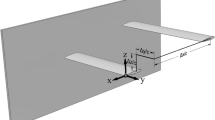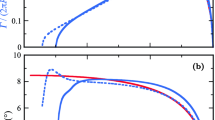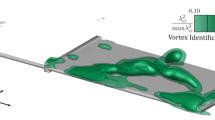Abstract
Experiments on a rotating wing in a liquid-filled tank were conducted to determine the minimum required tip clearance to produce data free from wall effects. A rotating wing fixed at an angle of attack of 45° was revolved for two revolutions at Reynolds numbers between 120 and 10,000. Tip clearance was varied from 0.5 to 5 chords by varying wing size, while also varying wing speed to hold Reynolds number constant. Force measurements on the wing, as well as dye flow visualization and particle image velocimetry of the entire tank, were conducted. Tip clearances of 0.5–7 chords were also tested computationally. Results of all measurements show large tip effects for 0.5 chords of tip clearance, and no wall effects for 5 chords of tip clearance at all Reynolds numbers tested. The 3 chord clearance case showed negligible wall effects in both the particle image velocimetry and dye flow visualization for all Reynolds numbers observed. The forces on the 3 chord tip clearance wing indicate wall effects appearing in the second revolution for Reynolds numbers of >1,000. A tip clearance of 5 chords is deemed to be free of wall effects for experiments limited to two wing revolutions within the range of tested Reynolds numbers.



















Similar content being viewed by others
References
Barlow JB, Rae WH, Pope A (1999) Low-speed wind tunnel testing, 3rd edn. Wiley-Interscience, New York
Carr ZR, Ringuette MJ (2014) Flow structure of low-aspect-ratio rotating wings from dye visualization. AIAA J Tech 52(5):1081–1086
DeVoria A, Mahajan P, Ringuette M (2011) Vortex formation and saturation for low-aspect-ratio rotating flat plates at low Reynolds number. In: 49th AIAA aerospace sciences meeting, AIAA 2011–396. Orlando, Florida. http://arc.aiaa.org/doi/pdf/10.2514/6.2011-396
Ellington C (1984) The aerodynamics of hovering insect flight. I. The quasi-steady analysis. Philos Trans R Soc Lond B Biol Sci 305(1122):1–15
Ellington C, van den Berg C, Willmott A, Thomas A (1996) Leading-edge vortices in insect flight. Nature 384(6610):626–630. doi:10.1038/384626a0
Garmann DJ, Visbal MR, Orkwis PD (2013) Three-dimensional flow structure and aerodynamic loading on a revolving wing. Phys Fluids 25(3):034,101. doi:10.1063/1.4794753. http://link.aip.org/link/PHFLE6/v25/i3/p034101/s1&Agg=doi
Graftieaux L, Michard M, Grosjean N (2001) Combining pov, pod and vortex identification algorithms for the study of unsteady turbulent swirling flows. Meas Sci Technol 12:1422–1429
Granlund K, Ol M, Taira K, Jantzen R (2013) Parameter studies on rotational and translational accelerations of flat plates. In: 51st AIAA aerospace sciences meeting, no. January in AIAA 2013–0068. Grapevine, Texas. http://arc.aiaa.org/doi/pdf/10.2514/6.2013-68
Hartloper C, Kinzel M, Rival DE (2013) On the competition between leading-edge and tip-vortex growth for a pitching plate. Exp Fluids 54:1447
Jones A, Babinsky H (2010) Unsteady lift generation on rotating wings at low Reynolds numbers. J Aircr 47(3):1013–1021. doi:10.2514/1.46649
Kim D, Gharib M (2010) Experimental study of three-dimensional vortex structures in translating and rotating plates. Exp Fluids 49(1):329–339. doi:10.1007/s00348-010-0872-6
Kolluru S, Jones A (2012) Effects of acceleration and pitch variations on a rotating wing. In: 50th AIAA aerospace sciences meeting, no. January in AIAA 2012–0050. Nashville, Tennessee
Lentink D, Dickinson M (2009) Rotational accelerations stabilize leading edge vortices on revolving fly wings. J Exp Biol 212:2705–2719. doi:10.1242/jeb.022269. http://www.ncbi.nlm.nih.gov/pubmed/19648415
Ozen CA, Rockwell D (2010) Vortical structures on a flapping wing. Exp Fluids 50(1):23–34. doi:10.1007/s00348-010-0888-y
Ozen CA, Rockwell D (2011) Flow structure on a rotating plate. Exp Fluids 52(1):207–223. doi:10.1007/s00348-011-1215-y
Schlueter K, Jones A, Granlund K, Ol M (2014) Effect of root cutout on force coefficients of rotating wings. AIAA J doi:10.2514/1.J052821
Taira K, Colonius T (2009) Effect of tip vortices in low-reynolds-number poststall flow control. AIAA J 47(3):749–756
Wang C, Eldredge JD (2012) Low-order phenomenological modeling of leading-edge vortex formation. Theor Comput Fluid Dyn 27(5):577–598. doi:10.1007/s00162-012-0279-5
Wojcik CJ, Buchholz J (2014) Vorticity transport in the leading-edge vortex on a rotating blade. J Fluid Mech 743:249–261
Acknowledgments
The authors would like to recognize Peter Mancini and Andrew Lind for their assistance in data collection and reduction. This work was supported by the Air Force Office of Scientific Research (AFOSR) Young Investigator Program (FA9550-12-1-0251).
Author information
Authors and Affiliations
Corresponding author
Rights and permissions
About this article
Cite this article
Manar, F., Medina, A. & Jones, A.R. Tip vortex structure and aerodynamic loading on rotating wings in confined spaces. Exp Fluids 55, 1815 (2014). https://doi.org/10.1007/s00348-014-1815-4
Received:
Revised:
Accepted:
Published:
DOI: https://doi.org/10.1007/s00348-014-1815-4




